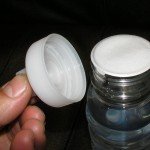Food Grade Induction Liners
Big Brand Cosmetic and Food Companies value their product being produced in Western Countries like the USA, Canada, Australia, New Zealand, The UK, Germany and France.
For example, a Salt Scrub that says produced in Canada carries a lot more appeal to clients and Brand owners alike than a product that says “Made in China”; Especially a product that you will Ingest or put into Direct Contact with your Body. The reasons are really quite obvious – it is common knowledge that in some parts of Asia where there is a huge ether of manufacturing, completely regulating all practices to be safe is a very difficult task. This leaves open an unacceptable risk for many consumers who will understand that “somewhere” in the chain of processes that go into the finished product something can more easily go wrong.
It is not uncommon to source packaging from Asia and then produce the contents in a more controlled and higher profile country or location.
If the brand (and clients) see value in knowing the contents are produced in a safe and controlled location then Induction Liners should NOT be considered as separate from the contents or as simply “inert” packaging.
Safe Induction Liners
The sealing layer of an induction cap liner that comes into contact with the inside area of your packaging is a plastic polymer and or an adhesive. Often cap suppliers will provide this lining material without paperwork to identify and qualify the material fit/safe for purpose. For example the liner may only be suitable for industrial chemical contents.
 During the induction sealing process, the lining material is heated to a point where their sealing polymers and adhesive are in a liquid/molten state. This can OFTEN mean liners from unknown suppliers in China will have a polymer cocktail that can leach into your (your clients) product*.
During the induction sealing process, the lining material is heated to a point where their sealing polymers and adhesive are in a liquid/molten state. This can OFTEN mean liners from unknown suppliers in China will have a polymer cocktail that can leach into your (your clients) product*.
The process of induction sealing could therefore result in some nasty compounds becoming an extra unintended ingredient in the product.
Please be assured that we are only raising this point to make sure you are aware of this possibility and to allow your client and you to complete a due diligence for the manufacturing of a product that will be in contact with people’s skin.
From our experience, the least that can be expected from a supplier of caps with lining material is to be given a cap lining certificate of compliance with food and commodities; supplied, on the letter head of the manufacturer of the lining material. It is not sufficient to have such a document issued by the cap supplier or a lining material agent that simply puts their letter head at the top of a generic declaration.
“Food for thought”
All our liners are manufactured using lining materials that have a cap lining certificate of compliance with food and commodities; supplied, on the letter head of the manufacturer of the lining material.
*Even the Foam we supply for fitting behind induction liners is resistant to the heat process of the Induction Sealing and this foam comes with it’s own certificate of compliance with food and commodities.
Often the first thing our clients realized with respect to how things can go wrong with Seals from Asia or India is inconsistency of sealing results. That problem , while a practical problem is a relatively minor problem. That is a relatively safe issue and it is well-known that this will often be due to variations from batch to batch of liners produced in these regions.
The safest way to treat induction lining material (and source it) is as if it were the contents.









Follow Us